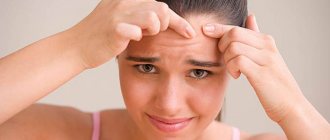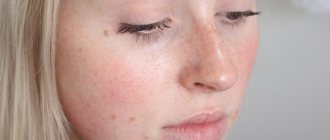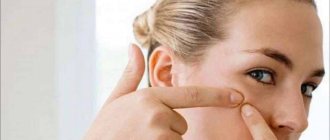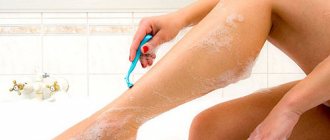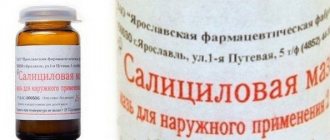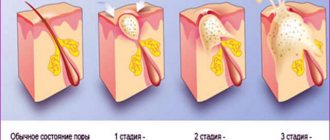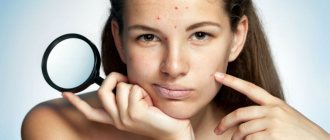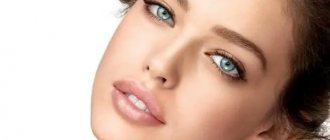Acne is a formation on the skin that can actively manifest itself at any age, depending on the pathology that affects the human body. But in teenagers this is quite normal. A logical question arises: at what age do teenage acne go away? To find at least an approximate answer to such a question, you must first understand the reasons for their appearance.
This provides general information about acne as a teenager, but the exact causes and age may not apply to your situation. The fact is that the formation of acne is an individual process. Much depends on the characteristics of your body. And especially if we are not talking about ordinary inflammation, but about neoplasms due to illness.
What causes acne in teenagers?
There is no specific reason. This is a combination of factors that affect the sebaceous glands and other elements of the skin, causing the formation of pimples and acne in adolescents. Among the most common reasons are:
- Regular disruptions in hormonal rhythm. This is due to changes in the body during adolescence. Especially during puberty, that is, from 13 to 16 years, on average. We are talking about androgens, which are highly activated at this age. They affect many glands in the body. But especially for greasy ones. As a result, they secrete large amounts of sebum, which clogs the pores. Over time, keratinized epidermal cells and external pollutants accumulate there. This is how acne appears. The most common places are the face, shoulders and back. Less often - stomach, chest, arms, legs.
- Stressful situations and teenage depression. When understanding why acne appears in teenagers, take into account the fact that many organs at this age are not working properly. Including the nervous system. Any, even the most minimal disorder, can provoke a disruption in its functioning. Namely, this system is closely connected with the sebaceous glands and other important parts of the skin. So, any stress can lead to the active appearance of acne all over the face. Sometimes this even becomes the cause of specific pathologies. For example, acne. In this case, acne must be treated to avoid the formation of purulent inflammation.
- Improper facial care. Teenagers have not yet developed a specific skin type. Therefore, any incorrect actions can lead to inflammation. Moreover, this can be either insufficient care or excessive care. For example, if a child does not wash his face in the morning, the sebaceous canals become clogged, the secretions cannot come out, and pimples form. But the situation can also turn out the other way around. If a teenager washes his face too often, it leads to the production of excess sebum. The skin becomes oily, again, the channels become dirty and inflammation affects the face. This process must be treated very carefully. During adolescence, it is recommended to wash your face twice a day – morning and evening. It is also recommended to use special cleansers, for example, Klerasil for acne.
- Hereditary predisposition. The appearance of acne on the skin of the face can be transmitted genetically from parents to children. If a mother or father suffered from oily skin as a teenager, this problem is likely to be passed on to their child. In this case, it is recommended to use special safe products for drying facial skin under the age of 18 years. In modern pharmacies there are many similar drugs for external use.
- Wrong cosmetics. This reason why acne appears in adolescence applies to girls. The fact is that most cosmetics contain fats. This is unacceptable for teenage skin, when the sebaceous glands are already unstable. It is generally not recommended to use any cosmetic products under 18 years of age. But today there are special lines of cosmetics for teenagers. They consist of components that cannot harm sensitive baby skin.
Even in the case of such cosmetics, it is recommended to consult cosmetologists. The fact is that skin can have individual properties. You cannot independently predict the reaction of the skin to this or that cosmetics.
Clinical picture of the disease
The appearance of juvenile acne on the skin indicates the development of a dermatological disease, the occurrence of which is associated with impaired functionality of the internal systems of the body, in particular the functioning of the sebaceous glands. As a rule, adolescent patients are susceptible to the disease.
The pathology is characterized by inflammatory processes in the area of the sebaceous glandular apparatus, the development of which is accompanied by the formation of small papules, open and closed comedones, and increased sebum secretion on the skin. With the development of pathology, papules transform into pustules; in advanced cases, boils and abscesses may appear.
READ ALSO: Wen on the leg: what it looks like in the photo, how to remove and get rid of it, as well as causes and treatment, what to do if the lipoma hurts and how removal occurs
Most often, the sites of localization of the disease are
Additional Information! According to statistics, the manifestation of pathology is typical for patients from 15 to 25 years old. The remaining 20% occur among representatives of a more mature age.
Usually the disease proceeds smoothly, without any complications and goes away on its own, but in 20% of cases it is necessary to seek medical help to eliminate the consequences of the development of pathology.
At what age do teenage acne go away?
No specific information. It all depends on how you take care of your skin, and whether you do it at all. But according to average data, teenage acne disappears completely at the age of 16-18. Provided that there are no pathologies in the body that can cause inflammation of the skin and sebaceous glands.
To delve deeper into this topic, be sure to check out these tips from medical professionals for treating teenage acne:
Between the ages of 13 and 16, acne actively affects most teenagers. But, if you take proper care of your skin, they will go away by the age of 17.
What is acne
Pimples is a general term for inflammation of the sebaceous glands. Sebaceous glands are located almost throughout the body, especially on the face, back and chest. They keep the skin elastic. The sebaceous glands are controlled by hormones. During puberty, the body produces more androgens, which stimulate the sebaceous glands. The skin becomes fatter and shiny.
Sebum production changes, leading to clogged pores. Comedones and blackheads form on the face and other parts of the body. Although this may not look good, it is not a sign of poor hygiene.
At what age do teenage acne go away in boys?
During puberty, boys suffer from acne more often than girls. This is explained by the increased level of testosterone in the blood of young men. It may seem that boys are not particularly interested in their appearance. This is wrong. Due to the psychological characteristics of this age, they worry about problems with their appearance and are ashamed of skin defects.
A selection of effective treatment methods
There are various ways to cope with teenage acne in girls. Be sure to identify the cause of the problem, visit a dermatologist, endocrinologist (in most cases, the culprits of the “triumph” are hormones). Be sure to explain to your child the rules that are prohibited from breaking in order to avoid unpleasant consequences.
What not to do:
- Don't squeeze pimples. Such actions lead to severe inflammation of the skin, the infection spreads rapidly, and scars form in place of the acne;
- It is forbidden to wash your face with hot water. Such manipulations trigger the active process of sebum production, bacteria develop faster, and the number of acne increases noticeably. Wash your face with cool water three times a day, using special cleansing gels. It is prohibited to use soap; it dries out the skin and aggravates the situation.
Drug therapy
The active components of pharmaceutical products effectively fight bacteria, inflammation, and cope with problem skin. Preparations:
- hydrogen peroxide. It has long been used for the prevention and treatment of rashes on the face and body, not only in adolescents. Before use, dissolve the product in water (proportion 1:3). Apply the resulting solution locally to pimples three times a day. The course of treatment is about one week;
- zinc ointment. The medicinal product soothes inflamed areas of the skin, relieves inflammation, promotes skin regeneration;
- Sulfuric ointment. The product is effective against fungi, mites, and bacteria. The ointment helps reduce oily skin, heals damage, and removes dead cells from the skin. The higher the concentration, the higher the effectiveness of the product. The only disadvantage of sulfur ointment is its sharply unpleasant odor;
- salicylic ointment. The medication has an anti-inflammatory and antibacterial effect. Apply a small amount of ointment to the pimple, cover with a band-aid, and leave overnight. The course of treatment is 10 days.
READ ALSO: Logoneurosis or stuttering in children: causes and treatment with breathing exercises and special exercises
The pharmacological industry offers a variety of ready-made medications based on the above components: Zenerit, Klenzit and others. The doctor selects a specific medicinal product after conducting several studies.
Talkers for teenage acne
They are a mixture of pharmacy components and homemade ingredients. Advantages of the products: low cost, absolute naturalness, ease of manufacture, high efficiency.
Anti-acne talkers for teenage girls:
- fruity. Combine two tablespoons of lemon juice with the same amount of plain vodka. Soak a cotton swab in the product and treat the area of inflammation twice a day. The course of treatment is no more than seven days;
- chatter with chloramphenicol. Combine 10 tablets of the drug, acetylsalicylic acid, analgin and streptocide. Crush all ingredients into powder. Add 100 ml of pure alcohol and a teaspoon of sulfuric acid to the resulting mixture. The prepared pulp is rubbed into the affected areas twice a day until complete recovery.
Folk remedies and recipes
Proven recipes:
- cucumber mask. Chop a small vegetable, add a teaspoon of lemon juice. Apply the resulting product to your face and keep it on for no more than 15 minutes. Repeat treatment procedures twice a week until complete recovery;
- Place fresh aloe leaves in the refrigerator for ten days. After the required amount of time has passed, pour the raw material with hot water in a ratio of 1:5, leave for one hour, put on fire, boil for three minutes. Cool the finished product, wipe your face with the medicine twice a day, pay special attention to areas where there is a large accumulation of acne;
- calendula against acne. Pour half a liter of boiling water over a tablespoon of dried flowers and leave for half an hour. Strain the finished broth, wipe the problem areas of the skin with it three times a day.
How to wean your baby from night breastfeeding? Find out now!
Read about the treatment of hip dysplasia in infants in this article.
At this address, find out the instructions for using Baby Calm drops for newborns.
Healthy eating
The child’s diet plays an important role: exclude fatty, salty, spicy foods, sweets, and carbonated drinks. Give your teenager plenty of dairy products, fresh vegetables, fruits, cereals, and lean meats. Light snacks are encouraged, and no more than 3–4 hours should pass between meals. Such actions improve the digestion process and have a beneficial effect on the general condition of the child.
It is impossible to prevent the active growth of a teenager; changes in the body are a completely normal process. Take your daughter to a dermatologist in a timely manner, apply preventive masks, use suitable cosmetics and care products.
Video - advice from Elena Malysheva on how to treat teenage acne:
